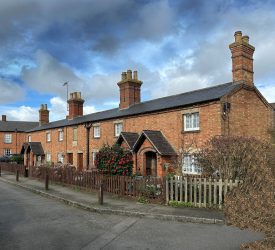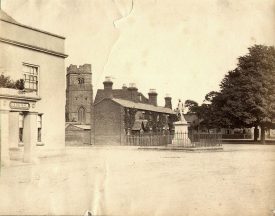The Newcombe almshouses were founded in 1693 by a bequest in the will of Thomas Newcombe the younger. Thomas had made his fortune in London as a printer to royalty and his widow Dorothy carried out his wishes. The six almshouses were intended for poor men and widows who had been born and lived in the parish. A document in the care of Warwickshire County Record Office has a copy of his will.1
The Building
The original building was a terrace, costing 150 guineas, standing on The Square near the parish church. It was completely rebuilt in 1818 and now consists of a 2-storey brick terrace with slate roof which is grade II listed. Each unit has a tiny front garden, but most of the back gardens disappeared when extensions with modern facilities were added in the 1940s.
Inscriptions
There is a plaque with an inscription that reads:
These almeshouses are the legacy of Tho: Newcombe esqr, printer to King Charles the 2nd, King James the 2nd & his present majestie King Wm the 3rd for the maintenance of 3 poor men & 3 poor widows born in the parish & built & endowed by his widow & executrix in the year of our Lord God 1693.
Other plaques were added later to record the 1818 rebuilding – funded by the Duchess of Buccleuch and Queensberry and the inhabitants of the parish – and the extensions added in 1949 in memory of Major Harold S Cazer and his wife of Dunchurch Lodge. Also Sidney C Turner clerk to the Newcombe and Spiers Charity Trustees. Spiers charity had been set up in the early 17th century for the benefit of the poor of Dunchurch and Newbold. Money from this charity helped build the original Newcombe almshouses and the two charities have been linked ever since.
The residents
By the time of the 1851 census there were four men and two women living in these almshouses: a former farm bailiff, a schoolmaster, an agricultural labourer, a sawyer, a shopkeeper and a field women. Thomas Morgan had his five year old grandson Edward living with him (possibly an orphan). In 1881 there were four women and two men: both former agricultural labourers. By 1901 there were only three men living there (one a former labourer) and it looks as though half the units were empty. All the adults had been born in Dunchurch or Thurlaston, a hamlet in the parish.
Support for the residents
The almspeople were receiving two shillings a week in the early 19th century, raised to 4s 6d by the 1830s.2 Clearly inflation got the better of the finances, because the they were only receiving 3s 6d a week in 1945. In the early 19th century they were receiving 12 cwt of coals a year and clothing costing £2 a head each year. By the 1870s Lady Scott was providing half a ton of coals each a year.3 Surviving accounts for the charity shed light on the maintenance of the property and care for the residents: in 1863 a blanket was purchased for one man and in 1872 3s 6d was spent on ‘Brandy for nurses’! These accounts also list some of the almspeople (and disappointed applicants) from 1862 onwards.4
References
1 Dunchurch Book of Wills and Charitable Gifts to ye Town, 1700s, Warwickshire County Record Office reference DR423/28.
2 Charity Commissioners’ Reports for Warwickshire, 1815-35, pp. 709-11.
3 White, F. & Co., History, Gazetteer, and Directory of Warwickshire, Sheffield 1874, p. 864.
4 Almshouse or Thomas Newcombe’s Charity from 1862-1951, Warwickshire County Record Office reference DR423/29.









Comments
Add a comment about this page